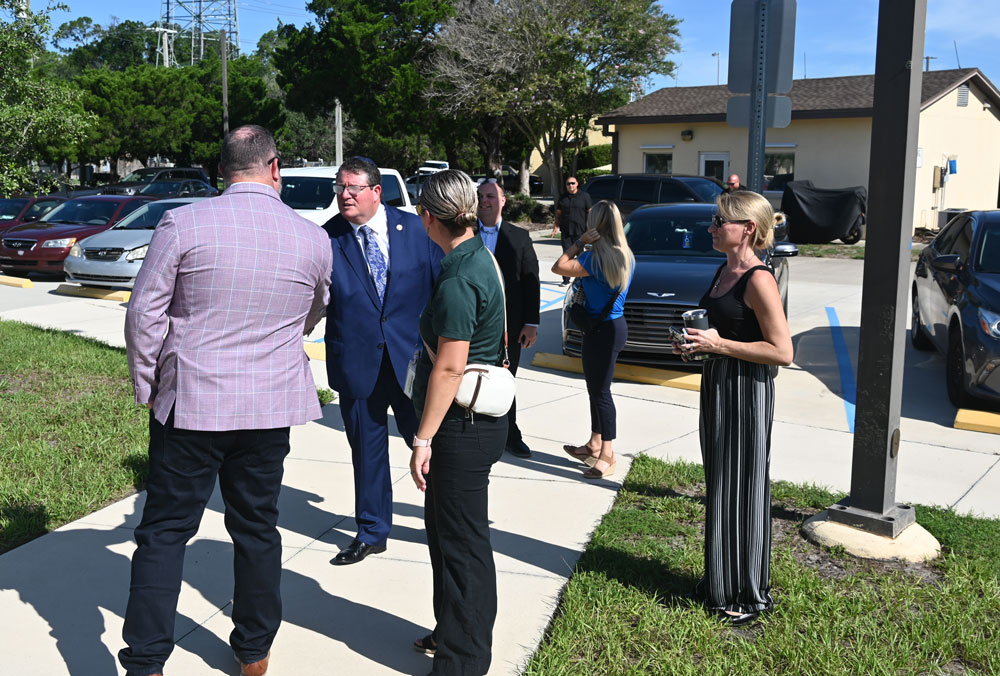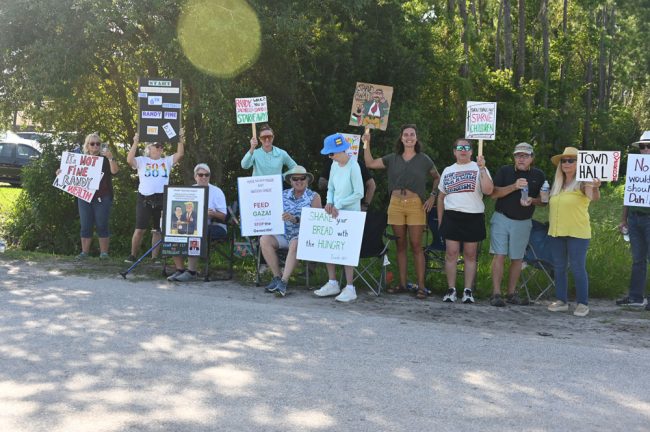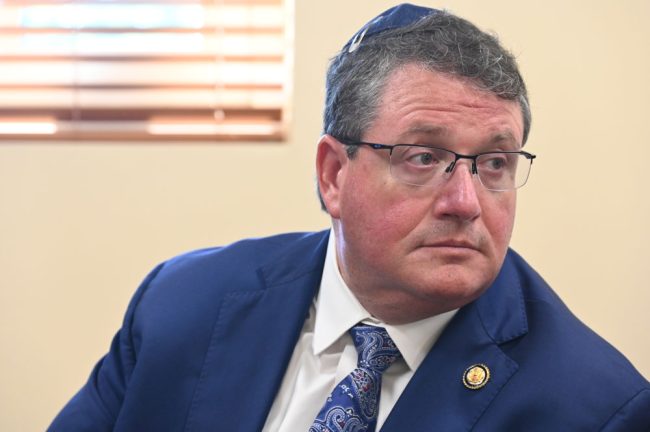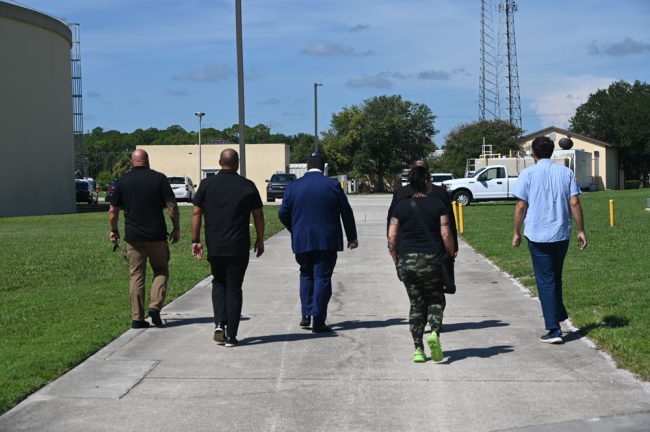
U.S. Rep Randy Fine, on a whirlwind tour of Flagler County that included an ATV trip along its battered beaches and an afternoon meet-and-greet at the Chamber of Commerce, this morning visited what has become a necessary stop in Palm Coast’s infrastructure calvary: the sloshing tanks and purifying basins of Waste Water Treatment 1.
Humorous and inquisitive when he’s not pandering to cameras with bigoted screeds, Fine said he “learned more about, you know, poop than I ever wanted to when I got elected legislature,” as Palm Coast utility staffers filled him in on the city’s troubled but mending sewer plant.
Fine had retained some of of that knowledge since leaving the Florida Senate on April 1 to take the congressional seat vacated by Mike Waltz, the district’s former congressman. Waltz spent 41 days as Donald Trump’s national security adviser before he was exiled to the United Nations ambassadorship over an oddly adolescent mistake for a former Green Beret.
Brief as it’s been, Fine’s tenure so far has been more controversies than accomplishments, as one of his two welcoming committees indicated today. A dozen and a half protesters had gathered on the two sides of Utility Drive as it branched off Old Kings Road to greet Fine’s car with signs that read “Starve Fine,” “Randy This is Not Fine,” “Feed Gaza,” “Thou Shall Not Starve Children,” “Randy Fine It’s Town Hall Time,” “Starve Away randy Fine,” a quote from Isaiah about sharing bread with the hungry, and so on.
His intimations of nuking Palestinians and other Arabophobic statements aside, Fine’s recent callout to Gazans to “starve away” has dogged him even from Republicans, who have been increasingly critical of his incendiary rhetoric. He has drawn five Republican challengers so far for next year’s primary, including the Palm Coast City Council’s Charles Gambaro and the Flagler County School Board’s Will Furry. Asked about the pile-up of challengers as he was ending his tour of the sewer plant in intolerable heat, Fine said: “I’m not super worried about it. The president asked me to run, and I think we’ll be fine.”
The Flagler County Sheriff’s Office had quietly arranged for security that also closely shadowed the congressman during his visit.

The welcoming committee at the other end of Utility Drive, nearer the plant, was sunnier: Interim City Manager Lauren Johnston, Vice Mayor Theresa Pontieri (who has been filling in as mayor on numerous occasions, Mayor Mike Norris being absent, as he was today), Council member Ty Miller, and Communications Director Brittany Kershaw. Fine shook hands with them all before taking a seat in a cool room for a brief presentation that he stretched as long as possible, so as not to face the heat. Council member Dave Sullivan and the newly appointed director of utilities, Brian Roche, were already in the room. Gambaro was not.
Danny Ashburn, the manager of wastewater treatment and reuse, led the presentation in granular detail, eliciting Fine’s jokes about pop but, more pointedly, a series of precise questions about the city’s wastewater infrastructure. He was not in a hurry. He was clearly not there just for show, but to learn, to probe, and on occasion to talk about what he knows. He was surprised by the extent of the city’s pep tank infrastructure, which Ashburn called Palm Coast’s “nemesis,” with 17,000 pep tanks in the ground, with 7,000 more to be entered as the city’s “infill” lots–in the old ITT-platted segments of the city–fill up, as they rapidly have been over the last few years. It’s those infill lots that have deluged WWTP 1 with waste.
“Pep tanks?” Fine asked. He’d not heard of them before. Not many people outside of Palm Coast have.
“They’re individual 1,500-gallon tanks. Think of a septic system without a drain field,” Ashburn told him.
“So where does the stuff go?” the congressman asked. Ashburn explained how the water is pumped to lift stations then piped to the treatment plants. But the entire infrastructure must be maintained and serviced by the city at huge cost.
When officials filled him in on the pending costs of expanding Waste Water Treatment 1 (a $280 million project over the next five years), Fine was stunned by the cost, which he estimated at $14,000 a house, or $20,000 a house when additional costs are included.
“This is getting back to my philosophy of government. It fundamentally is a local government responsibility,” Fine said. “We have this thing called Home Rule, and with the ability to home rule means–rule. So there are other options, right? There’s the impact fees and the user fees. The state [legislative] members often go and get appropriations projects to help with these kinds of things.” The federal government can occasionally help. He said he’d just secured $5.1 million for Bunnell’s sewer plant. But “the primary responsibility should be local. Because, you know, it’s a local responsibility.”
Pontieri gently reminded the congressman that while she fully supports home rule, “the state, though, has implemented laws that are forcing development on us to help with the affordable housing issues that we’re having, but at the same time not providing that funding, that infrastructure, that that development is causing. So it’s a hard contradiction.” She was referring for example to the Live Local Act.
Yet Bunnell had indeed secured that $5 million, following a trip to Washington by City Manager Alvin Jackson and Dustin Voast, Bunnell’s senior director for infrastructure, months ago. They’d started working on Waltz, then continued with Fine, for what had started as a $14 million project in 2022 and has since ballooned to $44 million, as utility infrastructure costs have continued to rise. (Tariffs aren’t helping.)
At one point Bunnell had secured more than the $14 million it initially needed, only to see the needs soar. Jackson said the city is still short $12 million, but has a pledge from the U.S. Army Corps of Engineers for the money, pending approval by Congress. “We really appreciate the congressman for shepherding that funding source for us,” Jackson said this afternoon.

Fine further explained his approach on local infrastructure: “My primary interest is on the things that extend beyond Palm Coast. So when sewage gets dumped into the Intercoastal, that doesn’t just affect Palm Coast, that affects all of Flagler County,” he said. “That doesn’t just affect all of Flagler County, that affects the whole east coast of Florida.” Making sure that the next 20,000 homes in Palm Coast have sewer, that’s fundamentally a Palm Coast responsibility, he said. “Making sure we’re not polluting the environment of Florida,” that’s a broader responsibility.
Pontieri and Miller were encouraged by the congressman’s visit. “We’re really looking for eyes and ears on the issue, not just this year, but in future years,” Pontieri said, “because we’re going to continue to have to invest in our system, just to make sure that again, we’re exhausting all funding sources, rather than having to go to store residents to shoulder a lot of the burden of this growth.” She said Palm Coast is just as concerned about improving waterways in and beyond Palm Coast, which ties into Fine’s more regional concerns.
“It’s important to educate [about] what our problems are, so I think we did a good job of that today,” Miller said. “We made a promise to the residents that we’re going to raise the rates, but we’re going to seek any avenue of alternative funding. So that’s the goal here, is to ultimately reduce the amount that we’re increasing the rates.”
![]()






























Mothersworry says
“Poop” is a fitting subject as that is all that spews out of his mouth.
The Slime says
Just confirms that Randy Fine could care less about the city or Flagler County. He is a real POS! I hope you MAGA folks who voted for him are pleased! Don’t expect anything from this asshole!
Pogo says
@Finally
… Fine in his true element.
JimboXYZ says
We all saw the score sheet under Alfin , the $ 1/2 bullion wants/needs that the State Grants never funded & grossly underfunded for what it did have a grant amount for. That’s Alfin-ville, his legacy of growing Palm Coast. Norris was so sandbagged being elected into this mess of a Vision of 2050 that is now rebadged as Imagine 2050. Alfin’s re-election slogan Fiscal Responsibility as a track record has done nothing but burden existing taxpayers with approaching billion dollar debt that will only grow. The current council a legacy of Alfin forming a welcoming committee seeking money from sources that aren’t forthcoming. Instead we get developers threatening to sue. What an epic mess 2021-present became & gets worse with each passing day. Biden’s “Build Back Better” that neither never was going to nor will happen because the money wasn’t there. And the realities of funding any project is the same kicking of the can down the street. Any money is coming from the masses of voters & taxpayers for jeopardizing their retirements. No moratorium enacted, Palm Coast continues to march as if Alfin were still mayor. Welcome to Alfinville, FL.
Palm Coast Infrastructure is a JOKE says
Get ready for another rate hike – the pond water they pump out to us is about to get even more EXPENSIVE people!!
Doug says
Randy Fine is correct in saying the infrastructure is the responsibility of Palm Coast. The city has recklessly spent the money set aside for a new wastewater plant, now they’re looking for a government handout? Wake up people, Palm Coast government doesn’t have the best interest of its residents. Look around and do your research. Matter of fact, visit other Florida cities that are about the same age as Palm Coast, and you’ll see the difference. There’s no comparison.
Geoff B says
Ahh, yes, but Randy Not Fine will always vote for billion$ for Israel, which he truly serves, where they get free healthcare and college, while Americans in this district struggle with aging infrastructure.
Denise Wilson says
Hmmm one would think that PALM COAST would have figured all of this in before OPENING THE FLOODGATES!!!!! Don’t put the burden on those who have been here forever, should have placed the burden on the NEW HOME BUILDING! You people are just running people out of the city!
Laurel says
It’s amazing to me how local politicians behave as if Trump and Fine are *normal*.
Labdon says
The rapid expansion here seems there could be some shady real estate deals going on.This city tax base has been growing since the Covid rush, those citizens over paid which raised their taxes,where’s the money going?This is atypical of outsourcing.Rarely do you here of or see open contract bidding.I gave written to the governor as Palm Coast needs a DOGE Audit!It sure seems like Real Estate Racketty.Palm Coast was founded as a Senior Community its why I moved here.Now its an over crowded Jacksonville suburb,Crime and all that gies with it!
JC says
Labdon, as someone who came from Jacksonville to Palm Coast you don’t even know what crime even is. Palm Coast is not a crime hell hole like North/Westside Jax. Regarding over crowded, please Palm Coast isn’t even close to it.
Canary says
So Randy Fine’s GPS can find Palm Coast after all. Must be time to start running for election I guess.
Incoming collapse says
lol clean air and clean water are your individual responsibility according to republicans. Good luck even getting tests for the 100s of thousands of chemicals haha!
Concerned Citizen says
Not a supporter of Fine. But..
Utility infrastructure is the responsibility of local governments. Instead of wasting all this energy getting mad at him. Invest directing it at our local representatives who are here every day. Start showing up for meetings. Start lighting up emails and phones. Start demanding they address local issues instead of fighting among themselves. And most importantly. Start reminding them they work for us. Not out of town developers.
Lastly if you want real change in this county. And I have said this many times before. STOP re-electing the same people who spew the same lame lies. Real change begins with us. And when the same people sit in office for 20 plus years. Who’s to blame for that?
Villein says
Failure to plan on your part does not constitute an emergency on my part. Everyone who warned against unbridled growth without impact fees sufficient to support infrastructure was fired. Corruption caused this mess and it was all done in full view of the public, but nobody was able to stand up to the developers, real estate agents and politicians. So we get stuck with the bill that has finally come due.
Kath says
Your worried about that, wait until communication cables are put in flagler Beach !!! How much electric do you think they will need ??? 🤔 get ready for those high electric Bills!!! Or a target on your back ! Where ever they put these in, Elictric bills ,are out of control…but 👋 we all think 🤔 this is a dam great idea 👏